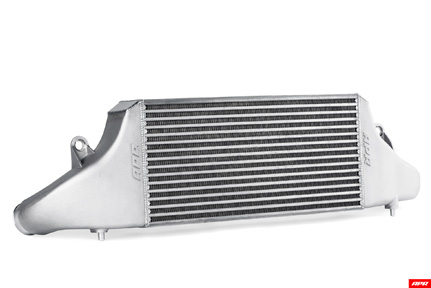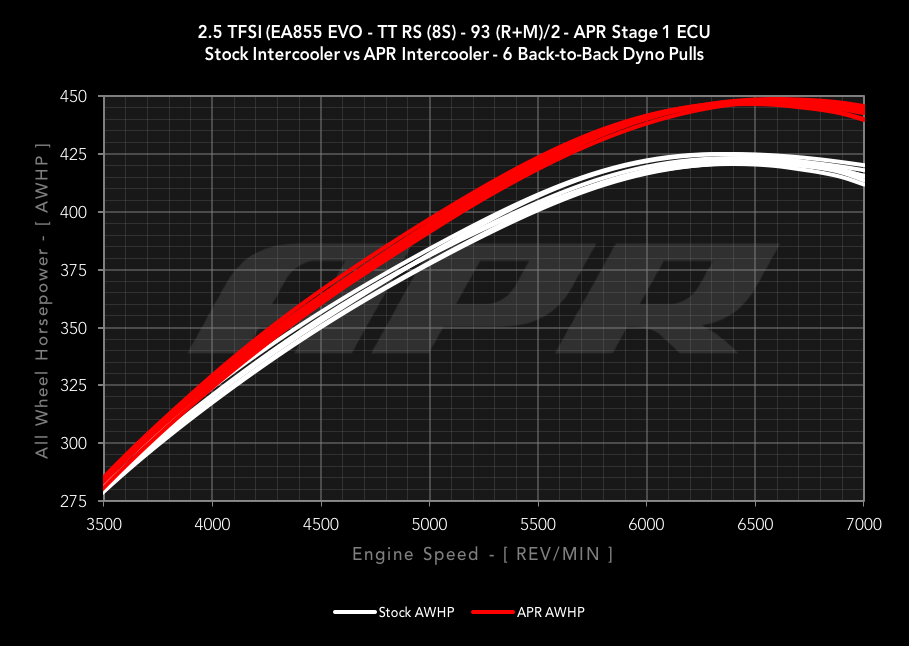Intercooler Core Design


The APR Intercooler core is a large bar-and-plate design featuring densely packed staggered and louvered fins. This design offers exceptional cooling while balancing pressure loss across the core, and maintaining critical airflow to the components behind the intercooler system. The core size was appropriately matched to the platform, minimizing pressure drop while leaving adequate space for appropriately designed end tanks. To APR’s mechanical engineering experts, the design represented the ultimate in performance, far exceeding the capabilities of the factory intercooler. To the driver, the result is simple: Repeatable performance, even in the most demanding of situations!
Core Style / Internal Fin Structure:
APR’s Engineers paid close attention to the balance between core effectiveness and pressure drop through the core, core style and fin density. With fin density too low, pressure drop decreases dramatically, but typically results in a core incapable of effectively cooling. Likewise, with fin density too great, pressure drop increases dramatically, resulting in the turbocharger working harder, and hotter, to produce the same level of airflow. By fine tuning this often unseen balancing act, as illustrated below, APR’s Engineers were able to maximize performance.

Internal Fin Structure
Core Styles
| Number |
Type |
Fin Type |
Fin
Density |
Pressure
Drop |
Cooling
Effectiveness |
Manufacturing
Cost |
Comments |
Recommended |
| 1 |
Tube and Fin |
Straight Channel |
Low |
Low |
Low |
£ |
Poor Cooling |
Not Recommended |
| 2 |
Bar-and-Plate |
Straight Channel |
Low |
Low |
Low |
££ |
Poor Cooling |
Not Recommended |
| 3 |
Quality Bar-and-Plate |
Staggered/Offset |
High |
Low |
High |
£££ |
Excellent Cooling
| Recommended! |
| 4 |
Overly Dense Bar-and-Plate |
Staggered/Offset |
High |
High |
High |
£££ |
High pressure drop |
Not Recommended |
Core Size:
APR’s Engineers also paid close attention to the balancing act between core effectiveness, pressure drop and space for end tanks through core sizing. With the core too small, pressure drop decreases dramatically, but typically results in a core incapable of effectively cooling. Likewise, with core size too great, pressure drop can increase, resulting in the turbocharger working harder. However, more importantly, with no space for appropriate end tanks, utilization of the core and overall effectiveness of the system diminishes rapidly, negating the benefit of the larger core. APR’s engineers were able to balance each of these characteristics to deliver maximum performance.
Core Specs
| System |
Core Type |
Thickness |
Width |
Height |
Volume |
Frontal Area |
| OEM |
Tube and Fin |
3.16" |
25.33" |
6.38" |
510.6 in³ |
161.6 in² |
| APR |
Bar and Plate |
3.5" |
22" |
10.4" |
800.8 in³ |
228.8 in² |
The APR system increases frontal surface area by 42% and has a 57% larger core!
| Intercooler End Tank Design →

















